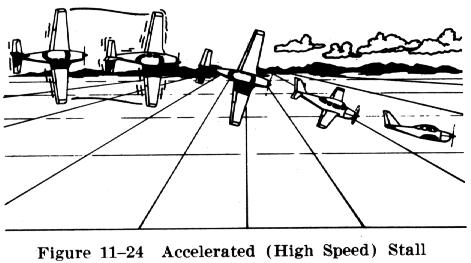
This demonstration stall, as in all stalls, is accomplished by exerting excessive back elevator pressure. Most frequently it would occur during improperly executed steep turns, stall and spin recoveries, and pullouts from steep dives. The objectives are to determine the stall characteristics of the airplane and develop the ability to instinctively recover when a stall occurs at other than normal stall speed or flight attitudes. A high speed stall, although usually demonstrated in steep turns, may actually be encountered any time excessive back pressure is applied and/or the angle of attack is increased too rapidly. This stall should never be practiced with wing flaps in the extended position due to the lower "G" load limitations in that configuration.
From straight and level flight at maneuvering speed or less, the airplane should be rolled into a steep level flight turn and back pressure gradually applied on the elevator control. After the turn and bank are established, back pressure on the elevator control should be smoothly and steadily increased. The resulting centrifugal force will push the pilot's body down in the seat, increase the wing loading, and decrease the airspeed somewhat. After the airspeed reaches the design maneuvering speed or within 20 knots above the unaccelerated stall speed, back elevator pressure should be firmly increased until a definite stall occurs (Fig. 11-24). These speed restrictions must be observed to prevent exceeding the load limit of the airplane.

When the airplane stalls, recovery should be made promptly, releasing sufficient back pressure and increasing power to reduce the angle of attack. If an uncoordinated turn is made, one wing may tend to drop suddenly, causing the airplane to roll in that direction. If this occurs, power must be added, the excessive back pressure released to break the stall first, then the airplane returned to straight and level flight with coordinated control pressure.
The pilot should recognize when the stall is imminent and
take prompt action to prevent a completely stalled condition. It is imperative
that a prolonged stall, excessive airspeed, excessive loss of altitude,
or a spin be avoided.